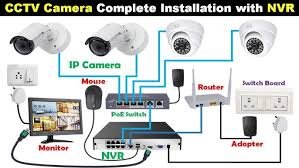
cctv camera installation
CCTV cameras have become a vital part of modern security systems, providing peace of mind for homeowners and businesses alike. With the increasing need for safety and surveillance, understanding the installation process, types of cameras, and how to maintain them is essential. In this article, we will discuss the key aspects of CCTV camera installation, including the benefits, types, installation steps, and maintenance tips.
Why Choose CCTV Cameras for Security?
CCTV (Closed-Circuit Television) cameras are used for surveillance purposes and have become one of the most effective ways to monitor and secure both commercial and residential properties. Here’s why you should consider installing CCTV cameras:
1. Enhanced Security
CCTV cameras provide constant surveillance, helping deter criminal activity like theft, vandalism, and break-ins. The mere presence of cameras can discourage potential criminals from targeting your property.
2. 24/7 Monitoring
CCTV cameras allow you to keep an eye on your property at all times, even when you are not physically present. With modern remote viewing options, you can monitor your cameras from your smartphone or computer, no matter where you are.
3. Evidence Collection
In the event of a crime or incident, CCTV footage can serve as crucial evidence to assist law enforcement and resolve disputes. High-quality video footage can help identify suspects, provide alibis, and even prevent wrongful accusations.
4. Insurance Benefits
Many insurance companies offer discounts on premiums for properties with CCTV surveillance systems, as it reduces the risk of damage or theft. Installing CCTV cameras can lower the likelihood of claims and potentially save you money on insurance costs.
Types of CCTV Cameras
Understanding the different types of CCTV cameras available is important for choosing the right system for your needs. Here are the most common types:
1. Dome Cameras
Dome cameras are one of the most popular types of CCTV cameras. They are named for their dome-shaped casing, which makes them less noticeable and harder to tamper with. These cameras are ideal for both indoor and outdoor use and are often used in stores, malls, and other commercial properties.
2. Bullet Cameras
Bullet cameras are long and cylindrical, typically used for monitoring specific areas such as entrances, driveways, or parking lots. These cameras often offer higher resolution and can be weatherproof, making them perfect for outdoor use.
3. PTZ Cameras (Pan-Tilt-Zoom)
PTZ cameras are highly versatile, offering remote control for pan, tilt, and zoom functions. These cameras are ideal for large areas or areas that require real-time monitoring. PTZ cameras allow you to focus on specific areas of interest, providing more detailed surveillance.
4. Wireless Cameras
Wireless CCTV cameras offer greater flexibility in terms of installation since they do not require cables for power and data transmission. They connect via Wi-Fi, allowing for easier placement in hard-to-reach or remote areas. Wireless cameras are popular for home security systems.
5. IP Cameras
IP cameras (Internet Protocol cameras) are digital cameras that transmit data over a network, typically over Wi-Fi or Ethernet. They offer high-definition video quality and allow for remote viewing. IP cameras are ideal for larger security systems where real-time surveillance and storage are necessary.
Steps for CCTV Camera Installation
Installing a CCTV camera system involves several steps, from planning to setup and configuration. Here’s a simple guide to help you through the process:
1. Plan Your CCTV System Layout
Before you start installing, it’s important to plan where you want to place the cameras. Consider the following:
- Entry and exit points like doors, windows, and gates
- Vulnerable areas like parking spaces, backyards, and storage rooms
- Areas with high foot traffic or high-value items
Ensure that your cameras are positioned to cover wide areas, minimizing blind spots. You may also want to consider night vision capabilities if monitoring during low-light conditions is essential.
2. Choose the Right Cameras and Accessories
Once you’ve identified the areas that need monitoring, choose the appropriate cameras. In addition to cameras, you’ll need several accessories, such as:
- DVR/NVR (Digital Video Recorder/Network Video Recorder) for storing footage
- Cables for wired cameras (Ethernet, coaxial)
- Power adapters for powering the cameras
- Mounting brackets for positioning cameras at the right height and angle
3. Install the Cameras
Follow these steps to install the cameras:
- Drill holes where necessary to mount the cameras securely.
- Position the cameras at a height and angle that provides the best coverage.
- Connect the cameras to the DVR/NVR via wires or Wi-Fi, depending on the type of camera.
- Power up the cameras using the provided adapters and ensure the video feed is working correctly.
4. Set Up the DVR/NVR
The DVR/NVR is the central unit that records and stores the video footage. Once the cameras are connected, follow these steps to set up the recorder:
- Connect the DVR/NVR to a monitor or TV to view the footage.
- Configure recording settings such as motion detection, recording time, and storage options.
- Set up remote viewing by connecting the DVR/NVR to the internet and downloading the appropriate mobile app or software.
5. Test the System
After installation, test the system by reviewing the footage from each camera. Ensure there are no blind spots and that the cameras are functioning properly. Adjust camera angles if necessary and verify remote access if you plan to monitor the system remotely.
Maintenance Tips for CCTV Cameras
Once your CCTV system is up and running, regular maintenance is crucial to ensure it remains effective. Here are some tips for maintaining your CCTV system:
1. Regularly Clean the Cameras
Dust, dirt, and debris can accumulate on camera lenses, affecting the video quality. Clean the lenses periodically using a soft cloth and a mild cleaning solution to remove any grime. If your cameras are outdoors, clean them more frequently to avoid dirt buildup.
2. Check for Obstructions
Over time, physical obstructions such as branches, wires, or dirt can block the camera’s view. Regularly check that the cameras are unobstructed to ensure they capture the desired areas clearly.
3. Test the System
Regularly test the system to ensure that all cameras are working properly. This includes checking the video feed, ensuring the motion sensors are functioning, and verifying remote access.
4. Update Software and Firmware
CCTV cameras, especially IP cameras, may require software or firmware updates for improved performance or security. Check for updates regularly to keep your system running efficiently.
5. Backup Your Footage
Ensure that your DVR/NVR is set to back up important footage. This will help you avoid losing critical data in case of hardware failure or system issues.
Conclusion
CCTV camera installation is an essential step toward enhancing the security of your property. By carefully selecting the right cameras, installing them correctly, and maintaining the system, you can ensure constant protection for your home or business. Whether you choose wired or wireless systems, indoor or outdoor cameras, or high-definition video options, the right CCTV system will provide peace of mind and act as a deterrent against criminal activity.
Investing in CCTV cameras today is a proactive measure that will save you from potential threats tomorrow. Make sure to follow the right installation steps and maintain the system regularly to ensure it serves you effectively for years to come.






